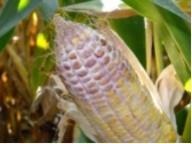By Taylor Dill
Corn harvest started earlier than normal this year across Ohio with many farmers taking advantage of higher grain prices and hauling in high moisture corn. This is causing more producers to switch back and forth between corn and soybean harvest. Considerations for choosing fields to harvest aside from weather are both stalk and ear quality.

Stalk rot development at the crown
Stalk strength and quality is affected by stalk rot, root growth, leaf health, and fertility. Most stalk rots are caused by a fungus in the genus Fusarium. Compounding stressors will heighten the severity of the stalk rot if the plant is infected. Stalk rot fungi survive in corn residue and enter the plant by wounds from corn borers, mechanical injury, or hail. Post silking is usually when the fungus will move from the roots to the stalks.
Root growth and leaf health both determine stalk strength by providing key nutrients for grain fill. The roots bring in water and nutrients to sustain the plant and leaf tissue is the source of photosynthetic bodies that create carbohydrates in conjunction with the roots. Cold and waterlogged conditions can restrict root growth, which many producers faced this spring with receiving both snow and pounding rain on early planted corn. This season has also been perfect for Gray Leaf Spot, Northern Corn Leaf Blight, and Tar Spot. These fungi kill photosynthetic material at the end of the season during grain fill, which can cause the plant to “cannibalize” or to take carbohydrates from the stalk to provide energy to finish grain fill. Similar to inhibited root growth and disease pressure at the end of the season, insufficient fertility, usually a nitrogen stress can cause cannibalization of the stalk. We have had many reports of premature plant death this year do to leaf disease mostly tar spot and plants running out of nitrogen.
There is no end of season management to mitigate stalk deterioration, but producers can minimize yield loss from lodging by harvesting fields with stalk quality issues early. One can use the “squeeze test” or “push test” to evaluate lodging potential. Use the thumb and the forefinger to squeeze the internodes and if the node is easily compressed then the stalk integrity has been compromised. For the push test, push the stalk 6 to 8 inches from vertical at the ear and if the stalk breaks between the ear and the lowest node, stalk rot is likely present. Assess approximately 20 plants in various location in each field, if more than 10-15% of stalks are rotted then the field should be considered for early harvest.
Ear quality should be taken into account when deciding which fields to harvest first. To assess ear quality, remove the husks from several ears in multiple areas of the field and observe the ear. If Giberella ear rot or Fusarium kernel rot is present in a considerable population, then consider harvesting these fields earlier. If ear rots are present, consider possible combine adjustments such as increased fan speed to decrease infected grain in the final grain sample.

Giberella ear rot

Fusarium Kernel Rot
The decision to harvest wet grain increase drying cost, but down corn also increases harvest challenges, ear losses, and decreased grain yield. The average cost to dry corn is 0.02 gallons of propane per point per bushel of corn dried. Drying corn an extra 5% takes an extra 0.1 gallons of propane. The decision to harvest early can maintain bushels in the bin and make for a safer fall harvest.
Source : osu.edu